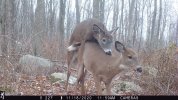yoderjac
5 year old buck +
And, you received your degree in wildlife biology from where? With all due respect, it is not “impossible” to change the genetic makeup of a free ranging group of whitetails. I don’t believe in “culling”, but high grading is not culling. I do agree that 50 percent of the genes come from the doe, and there is no way to know what she is carrying genetically. However, very few and I mean very few bucks within a three mile radius (an area that will hold most bucks 85% of the time) are ever going to reach 170 inches. In my case, we have harvested far too few bucks over the years. Most years we only harvest 2-3 bucks on 2500 acres. They have always been some of our best bucks. On that 2500 acres we generally never had more than 1-2 bucks that were at or above 170. I am just throwing out numbers, but if there are 30 deer per square mile on my farm which is probably close to right, then 85 % of the bucks that are breeding are throwing genes that did not produce a 170. Again, the doe is a wildcard, but you can rest assured the average score of the bucks on my farm has declined in 20 years.
Sent from my iPad using Tapatalk
I thought "culling" was selectively removing animals from the herd. Maybe I don't understand "High Grading". I thought that it was targeting large antlered bucks. Do I have it wrong?
I agree that "impossible" is probably an overstatement. "Unachievable" might be a better description. In order to have a genetic impact, culling would need to be so severe that it simply won't happen in a free ranging deer herd. If a degree is what convinces you, take a listen to those two pod casts. There is a lot of paper hanging on the walls of those guys. What I find even more impressive is that they modeled the problem and then conducted a field study over 7 years on 100,000 acres and the measured results matched the genetic model.
The pod cast provides much more detail than I can list here, but they had 3 areas, a control area with no culling, an area with "moderate" culling, and an area with "Severe culling". The results between these areas was compared.
It is pretty easy for us to draw the wrong conclusions from anecdotal observations, especially when the underlying processes are counter intuitive. Our nature is to infer causal relationships from correlation and to assume statistical significance where it does not exist. We fail to see our own biases. A great example was a study done when hunters were asked to carry a device in their pocket. After the hunt they were asked to complete a post hunt survey with a variety of questions about what they observed and other things regarding the hunt. The study question was imbedded in the survey asking them to estimate how far they walked into the woods from their vehicle. The device ended up being a GPS recorder and the hunters had a huge overestimate of how deep into the woods they went. Similarly, we keep a hunting log of every hunt on our farm with observations. In years with bumper acorn corps we all thought (including myself) that deer numbers were down. It wasn't until we established the wireless camera network and began collecting year-round data that we learned were simply more responsive to hunting pressure those years. Deer just became more nocturnal when food in cover was bountiful and we observed fewer deer.
Our ad hoc observations can be great at helping us form a hypothesis, but until we collect and analyze data, it is just a hypothesis. The data can support or debunk it.
I think the data has spoken pretty loudly in this case.
Thanks,
Jack

